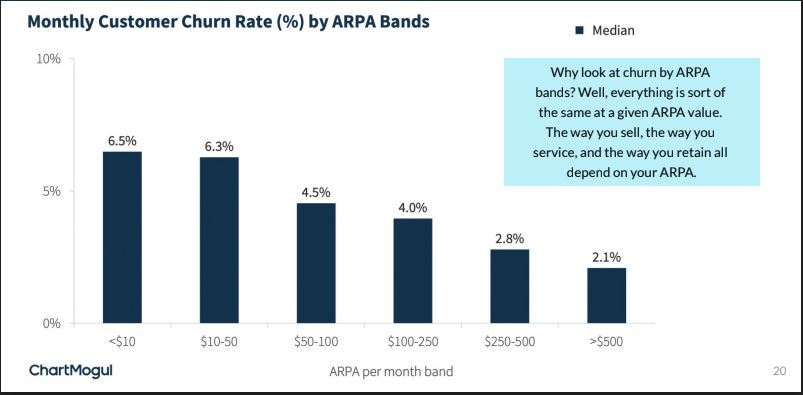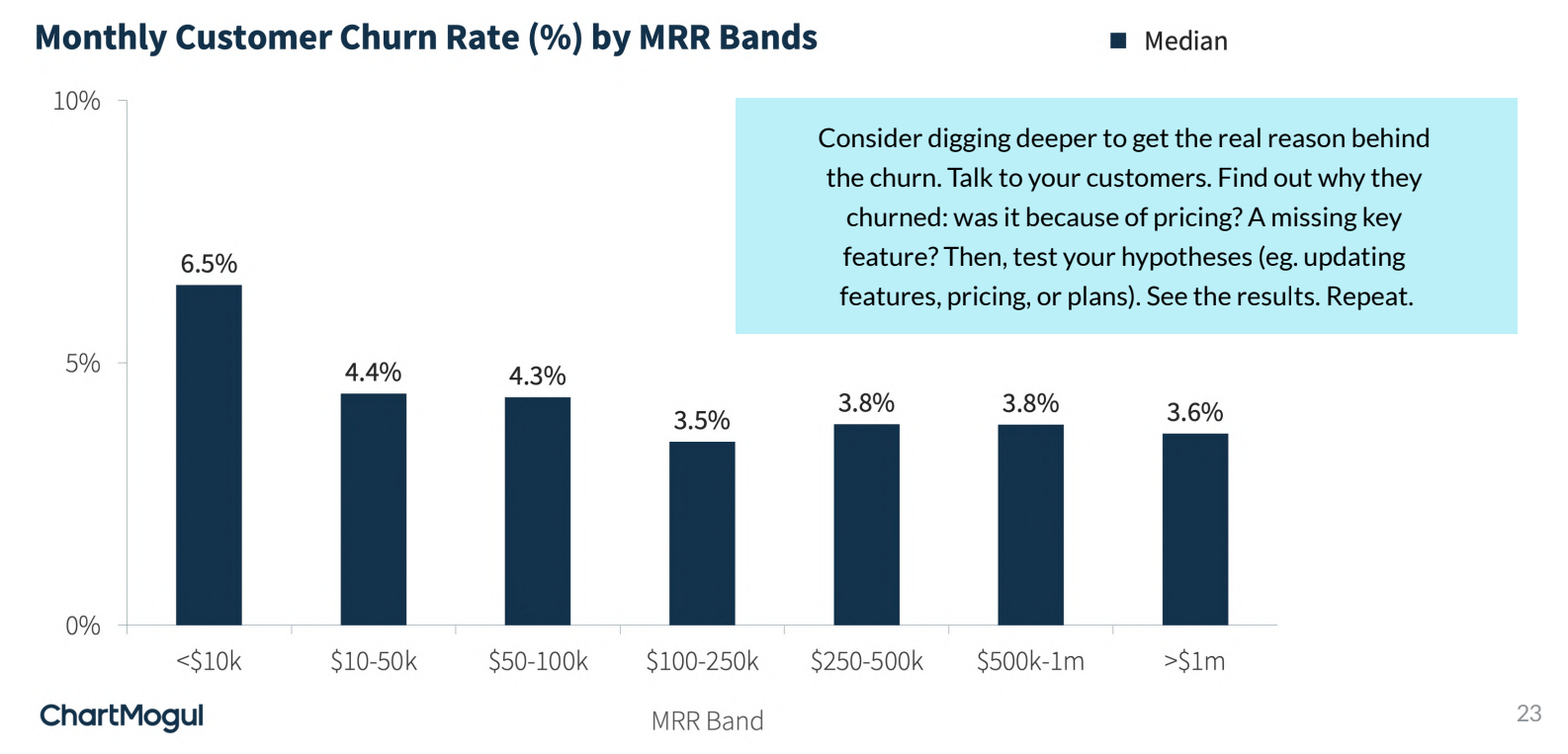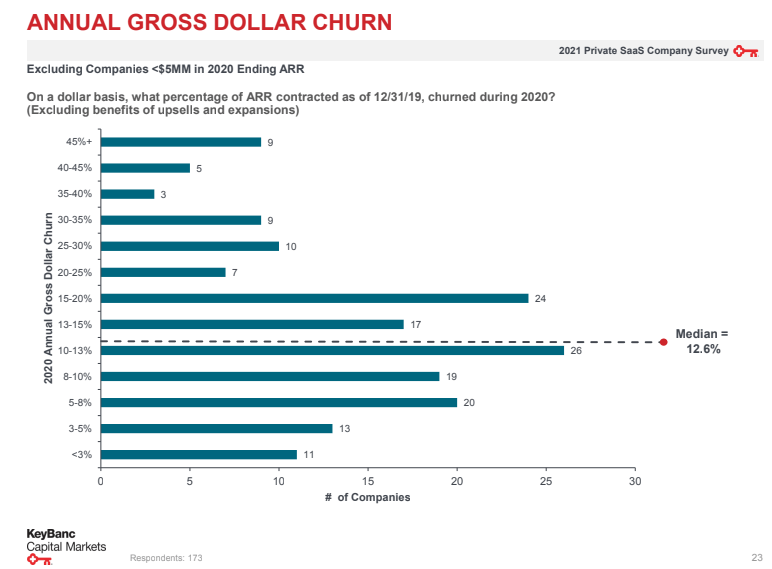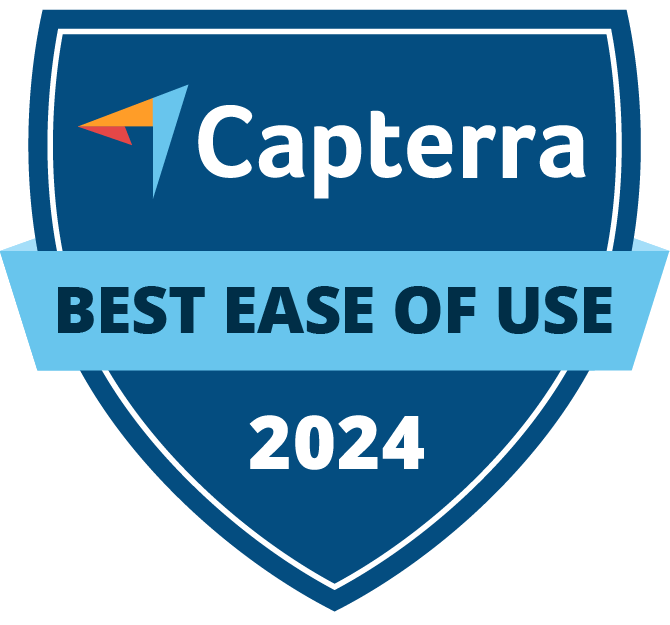How to calculate and lower SaaS churn rate


As soon as a company operates with recurring revenues such as customer subscriptions, customer retention becomes critical. The term used to describe the loss of recurring revenue or customers is churn or attrition.
Find out in this article how to calculate churn correctly, why managing it is essential, and how to reduce customer churn effectively.
What is churn rate?
“Churn” means attrition. While winning new customers is essential for business growth, the real key to success for subscription-based companies is to retain customers for as long as possible. According to McKinsey, retaining existing customers is often a more efficient growth strategy for SaaS companies than aggressive acquisition.
Revenue and customer churn rates for SaaS
Over a given period, churn can be measured in terms of either:
- Revenue churn: the loss of Monthly Recurring Revenue (MRR) due to customer cancellations or contract downgrades.
- Customer churn: the number of customers lost over a period relative to the total number of customers at the beginning of that period.
💡 Contraction refers to lost revenue from canceled contracts or downgrades to cheaper subscriptions.
How to calculate churn rate
Let’s walk through a concrete example:
- 90 customers subscribe to a plan costing €200 per month, generating an MRR of €18,000.
- 50 customers subscribe to the premium plan at €400 per month, generating an MRR of €20,000.
- 5 customers cancel their basic subscription.
- 2 customers cancel their premium subscription.
- 1 customer downgrades from premium to basic.
Revenue churn calculation:
(5 × 200)+(2 × 400)+(400−200)=2,000 euros
Revenue churn rate:
2, 00018, 000 + 20,000 = 5.26%
Customer churn rate:
5 + 290 + 50 = 5%
Why track churn rate?
Acquiring customers takes time and money—especially in terms of marketing, sales, and team salaries. Retaining customers over time helps maintain your MRR at a much lower cost than acquiring new customers.
This is why churn rate is one of the essential SaaS KPIs to measure and manage.
Churn is an essential KPI for SaaS companies
Some businesses rely on recurring revenue, such as SaaS companies that offer access to online applications through monthly or annual subscriptions. To succeed, these companies need to focus on retaining customers by tracking and managing their churn rates.
Maximizing the average lifespan of a customer directly affects profitability. Since Customer Acquisition Cost (CAC) is often high, the only way to achieve sustainable growth is by maintaining a low churn rate and increasing average subscription duration.
Compare your churn rate to industry benchmarks
It’s important to regularly calculate churn indicators for businesses with recurring revenue. But how can you tell if your churn rate is too high? Setting clear SaaS metrics and using benchmark data can help with the analysis.
🔎 Two key insights to keep in mind: churn rates are linked to both average revenue per account (ARPA) and monthly recurring revenue (MRR).
Here are two analyses from ChartMogul’s SaaS Benchmarks Report.
The higher the ARPA, the lower the customer churn rate:

The same is true of the customer churn rate, as shown in this graph which breaks it down by MRR:

A 2021 study by KeyBanc Capital Markets, which surveyed 350 SaaS companies, found that when excluding companies with less than $5 million in ARR (Annual Recurring Revenue), the median annual revenue churn rate in 2020 was 12.6%. Here’s how the churn rates are distributed among companies:

{{discover}}
How to lower your company's churn rate
Tracking churn allows companies with recurring revenues to take corrective action that can improve user satisfaction and increase their chances of growth and success. It also helps them evaluate and refine their offerings.
General strategies for reducing churn
Churn is a metric that companies can influence. Here are several ways of analyzing and managing the attrition rate:
- Understand your customers – Identify the reasons for churn through surveys and feedback.
- Improve your product – Ensure your product meets customer expectations. Hubspot found that customers who used at least three product features were significantly less likely to churn.
- Run customer loyalty campaigns – Offer incentives for long-term subscriptions.
- Enhance the customer journey – Provide a personalized and smooth user experience.
- Optimize pricing models – Adjust your pricing to better match customer expectations.
- Improve customer support – Use tools like live chat to resolve issues quickly. Resolving a customer's issue during their first interaction can prevent up to 67% of churn.
- Streamline customer onboarding – A poor onboarding experience can lead to early cancellations and accounts for 23% of customer churn.
- Segment customers – Tailor your approach based on customer personas.
Reduce technical churn from payment failures
Technical churn affects many companies with recurring revenue, often due to expired credit cards. If customers don’t update their payment details in time, their subscriptions are immediately impacted. GoCardless found that at least 11% of failed payments will result in customer churn.
SaaS companies can reduce churn by setting up automated reminders to update payment information before the expiration date.
Practical tools for managing customer feedback
A strong marketing strategy now includes after-sales service and data analysis to identify why user satisfaction is declining. Setting up multiple feedback channels is a reliable way to reduce churn.
Here are some useful methods for gathering feedback:
- Live chat – Engage with customers in real-time.
- Exit surveys – Use surveys during the cancellation process to understand why customers are canceling.
- Follow-up emails – Collect feedback through automated post-cancellation surveys.
According to Churnfree, companies that actively gather and act on customer feedback are more likely to keep churn below the industry average of around 5%. Those that fail to leverage this feedback often struggle to retain customers and fall short of this benchmark.
Correctly calculating your revenue and customer churn rate is a prerequisite for improving customer retention.
Fincome helps you manage your performance with fast, reliable reporting. Request a demo to see how our platform can help you track and reduce churn.
{{newsletter}}


Discover Fincome!

Frequently Asked Questions
Expense Tracking:
Fincome is a SaaS revenue management platform designed specifically for companies with recurring revenue models (any business selling subscriptions).
Fincome automates the tracking and management of your revenues and associated KPIs (churn, LTV, CAC, etc.) in real time, without the need for a data team or manual processing, thanks to direct integrations with your billing systems and ERP.
Unlike generic BI tools, Fincome offers a turnkey, intuitive solution tailored to the specific needs of subscription-based businesses, enabling seamless collaboration across your finance, GTM, and CSM teams.
Fincome is built exclusively for companies with recurring revenue models, meaning those that track MRR or ARR, such as:
• Software publishers (SaaS)
• Media companies
• Mobile apps
• Any other B2B or B2C subscription business looking to professionalize revenue management
Fincome supports organizations at every stage of growth, from startups to mid-market and large international enterprises.
With Fincome, you gain access to a full suite of modules:
✅ Revenue: detailed ARR/MRR breakdown, cohort analysis, detection of billing errors or omissions, revenue recognition and deferred revenue (PCA)
✅ Growth: analysis of ARR movements (new business, expansion, churn, reactivation), identification of growth drivers
✅ Unit Economics: LTV, CAC, and LTV/CAC analysis by segment, channel, or geography to optimize margins
✅ Retention: deep cohort analyses, identification of key retention drivers
✅ Renewals: future MRR projections, opportunity forecasting, and churn risk reduction
✅ Forecasting: revenue growth scenario modeling to better inform strategic decisions
Fincome is the only turnkey platform built specifically for recurring revenue businesses that combines:
✅ A complete, reliable view of your recurring revenues (MRR, ARR, churn, LTV, CAC, cohorts, renewals, revenue recognition, deferred revenue)
✅ Fully customizable, automated, shareable reports powered by AI, delivering actionable insights to guide your strategic decisions
✅ Expert support to help structure and interpret your analyses, without needing to build an internal data team
✅ The ability to generate future growth scenarios, compare them side by side, and track actual vs. forecasted performance, all in real time
Unlike traditional BI tools, which require you to build and maintain your own metrics (often consuming internal resources just to produce static data visualizations), Fincome transforms your SaaS metrics into concrete, actionable recommendations — helping you move faster, with more impact and operational efficiency.
Yes! If you use an unlisted or in-house billing system, no problem — you can easily import your billing data via Excel or push it through our public API. You can access our public API documentation here.
With Fincome, you can:
✅ Reduce up to 90% of the time spent calculating and reporting your KPIs
✅ Make faster, more accurate strategic decisions
✅ Recover up to 5% of lost revenue by detecting errors or omissions
✅ Cut the risk of manual spreadsheet errors by 80%
Absolutely. Data security is at the heart of what we do. Fincome is SOC 2 Type I certified, ensuring a high level of data security and protection.
Your data is collected exclusively via read-only APIs and hosted on secure servers located in France. We never share your data with third parties without your consent.
For a detailed review of our security practices, please visit our dedicated security page.
At Fincome, customer success is a core priority. We guide you from the very start — structuring your data, training your teams, and optimizing your use of the platform to deliver value quickly.
Our team remains by your side to answer strategic or technical questions, share best practices, and help you get the most out of your analyses.
Simply request a demo on our website. We’ll walk you through the platform, assess your needs, and guide you through a smooth deployment.
Most deployments and team trainings take no more than two weeks to get fully up and running.
👉 Request a demo
Income Analytics:
Lorem ipsum dolor sit amet consectetur adipiscing elit etiam vehicula. Etiam vehicula condimentum nunc, a semper elit luctus id. Duis fringilla enim non neque aliquet.
Lorem ipsum dolor sit amet consectetur adipiscing elit etiam vehicula. Etiam vehicula condimentum nunc, a semper elit luctus id. Duis fringilla enim non neque aliquet.
Lorem ipsum dolor sit amet consectetur adipiscing elit etiam vehicula. Etiam vehicula condimentum nunc, a semper elit luctus id. Duis fringilla enim non neque aliquet.
Budget Management:
Lorem ipsum dolor sit amet consectetur adipiscing elit etiam vehicula. Etiam vehicula condimentum nunc, a semper elit luctus id. Duis fringilla enim non neque aliquet.
Lorem ipsum dolor sit amet consectetur adipiscing elit etiam vehicula. Etiam vehicula condimentum nunc, a semper elit luctus id. Duis fringilla enim non neque aliquet.
Lorem ipsum dolor sit amet consectetur adipiscing elit etiam vehicula. Etiam vehicula condimentum nunc, a semper elit luctus id. Duis fringilla enim non neque aliquet.
Wealth Management:
Lorem ipsum dolor sit amet consectetur adipiscing elit etiam vehicula. Etiam vehicula condimentum nunc, a semper elit luctus id. Duis fringilla enim non neque aliquet.
Lorem ipsum dolor sit amet consectetur adipiscing elit etiam vehicula. Etiam vehicula condimentum nunc, a semper elit luctus id. Duis fringilla enim non neque aliquet.
Lorem ipsum dolor sit amet consectetur adipiscing elit etiam vehicula. Etiam vehicula condimentum nunc, a semper elit luctus id. Duis fringilla enim non neque aliquet.






